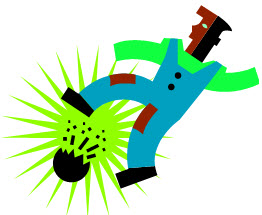Source of article Jury Insights.
Part 2:
Taking Turns;
Being Brief

Taking Turns
Explain to your key witness that a deposition is not like an ordinary conversation or interview. Testimony is a bit more like a tennis match in which you wait for the ball to come over the net, and then you hit it back. Another analogy is the visual image of catching a baseball and holding it momentarily before throwing it back.
In training this concept, sometimes it is helpful to use an object (like a coffee mug or cell phone) to create a speaking baton, and physically pass it back and forth during a role play demonstration to get this point across.
There is no set amount of pause time before answering, but if it helps the witness to visualize it, offer the image of looking both ways before stepping off the curb to cross the street.
You are not encouraging the witness to stall, but to take a moment to consider an answer before answering. Time is always on the side of the witness. When listening to music, no one doubles the speed to get to the end of the song as quickly as possible; we listen to the melody, tone and the lyrics. Hear the question. Understand the question. Ask to clarify an unclear question.
Answer me now…
In a tense exchange at the United Nations during the Cuban Missile Crisis (October 25, 1962) Adlai Stevenson forcefully asked the Soviet representative, Valerian Zorin, if his country was installing missiles in Cuba.
Stevenson was so wired that he raised his voice and demanded, “Don’t wait for the translation, answer ‘yes’ or ‘no’!”
Likewise, instruct the witness that you will object if opposing counsel attempts to trample on an answer, coerce or pressure an answer.
This is a good time in the training to explain the purpose of your objections that will occur from time to time at the juncture of the bounce-pause following the question.
Teach your witness that every objection is a signal to ask to have the question repeated.
Being Brief
Old joke.
A lawyer asks a witness, “What is your date of birth Mr. Jones?”
The witness responds, “June 5.”
The lawyer says, “No, what year?”
The witness responds, “Every year.”
You want your witness to be brief and limited in response, within reason.
Instruct the witness to answer only the question that is asked, and nothing more. Don’t try to read the mind of the examiner, and don’t anticipate that you will save time, hassle or control the examination by saying more than the minimal amount necessary. Don’t volunteer anything. Don’t fill in for the examiner’s pregnant pauses or expectant glances.
I would guess that 80% or more of the questions during a deposition beget an answer that I would characterize as, “what’s so,” and also, “so what.”
In other words, most answers are merely going to be undisputed facts that do not merit concern, resistance or haggling. A minority of questions are going to provide an opportunity for the witness to reach a landmark fact or theme, or require maneuvering to avoid an opposition landmine.
It takes very little energy for the witness to allow the examiner to lead the dance through the “what’s so/so what” questions. The witness posture is one of relaxed vigilance, answering each question with a brief, limited, concrete one sentence response that begs the next limited question. The witness must patiently wait for opposition counsel’s transition to the landmine subject content.

It is sometimes challenging, but still important, to give a brief, limited answer to a landmine question…
Landmine questions are often variations on “what do/did you know?” and “when did you know it?”
The successful witness must have the capacity to understand not only case strategy, but also the subtleties of perceptual experience, personal meaning and the evolution of personal understanding over time. If the witness is not capable of parsing “what do/did you know?” and “when did you know it?” there is probably going to be trouble.
Landmine questions require a brief, limited response that is also going to be a qualified response. Opposing counsel asks, “When did you first become aware that you had this unusual mole in your armpit?” “How long did you wait before making appointment to look into it?” “Prior to that appointment with Dr. Jones when did you previously see her?” “Did Dr. Jones tell you to come back if it changed?” “When did you first notice that it changed?” Perception, meaning, time frame, understanding over time. Witness testimony about these “facts” must embrace both the plaintiff and defense case strategies and attempt to reach a landmark without falling onto a landmine.
We know from the research regarding eyewitness testimony that perception is incomplete during encoding and that memory is plastic over time. There is a certain reality to the notion that while we may be “sure” about our “certainty” it doesn’t mean there is anything other than personal truth to it. To make matters more difficult, we are often not even sure of our certainty.
Opposing counsel attempts to manipulate and take advantage of these phenomena, first by creating the expectation that the witness should know the exact answer, as if the witness walks around with a camcorder running to a gazillion gigabyte hard drive, and then trying to pin the witness down to a hard and fast appraisal.
The attorney must have a good grasp on the relative importance of the impression of testimony in contrast to the importance of individual facts and help the witness make a landmark impression within the limits of what is knowable.
Part 3 will address how the witness can deal with some of the techniques opposing counsel uses to derail testimony including: a “yes set” of leading questions, “bracketing” perceptions of time, space and speed; and inviting speculation.
Next in Part 3:
How do you train your key witness to recognize opposing counsel’s ploys to undermine credibility?
Alan J. Cohen Ph.D. LLC
